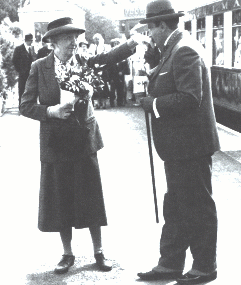Fictional World of Agatha Christie
In the fictional world of Christie, there are historical figures and events included in her books. There are many fictitious towns of England and even countries in her world. Some political groups and events are hers only, and yet they are recognizable in the real world. Christie's world is really her own, as with any author (one doesn't have to look any farther than another popular writer like J. K. Rowling). Even in her world of England and detective fiction, Christie's two popular sleuths Poirot and Marple have never met. Let's look at this first.
Poirot & Marple: Same Universe?
Many Christie readers have asked themselves why on earth (pun intended) Poirot and Marple have never met. Perfect answer is from Agatha Christie herself (from An Autobiography): "but why should they?" Christie says these two wouldn't get along at all. She says, "Hercule Poirot, the complete egoist, would not like being taught his business by an elderly spinster lady." Christie argues that he is a professional and therefore would not have place in Marple's "world", as Christie puts it. She stated that she would never place them in the same story, unless "I feel a sudden and unexpected urge to do so." I would have always liked it if they had met, but I do agree with Agatha Christie.

Poirot and Marple met for the first time in 1990 for Agatha Christie's centenary celebration in her hometown of Torquay. David Suchet portrayed Poirot at the time (he recently finished portraying Poirot on television). Joan Hickson here portrayed Miss Marple, as well as on the television series between 1984-1992.
Poirot is a professional, not Marple. Poirot has more help and access to information by being--again--a professional. He has the local police, Scotland Yard, Mr. Goby, and people of influence as recourse. Not Marple. Poirot is in exlusive and popular circles of London. Not Marple; she doesn't go meet people of society and mingle with them. She stays in her village of St. Mary Mead, whereas Poirot travels the world. Of course, Marple has been to the Caribbean on holiday, but Poirot has been to many more cultures because he has the money and means to do so.
He would never have met the Beresford couple, also. Tommy and Tuppence were amateur detectives--why would they work with Poirot? The Beresfords also had a family. Poirot and Marple surely belonged to families, but they themselves never married. (More on Tommy and Tuppence later...)
Proof of Same Universe Theory
So, the question: did Poirot and Marple actually exist in the "same" universe of Christie's? The answer would be "yes", through linking common facts together like a spider's web (or like the famous Six Degrees of Kevin Bacon!).
- Poirot has met and collaborated with Mrs. Ariadne Oliver, the mystery writer, on many occasions.
- Ariadne Oliver has met the Reverend Dane Calthorp and his wife in The Pale Horse.
- Reverend Dane Calthorp and his wife are friends of Marple, as evidenced in The Moving Finger.
Two more connections can be made between Poirot and Marple, only indirectly.
- Poirot met the young lady Katherine Grey from The Mystery of the Blue Train, having lived in St. Mary Mead.
- St. Mary Mead is of course the village where Miss Marple lives (although some has dismissed this, saying that there are two villages with same name).
Here is another connection:
- Poirot has met the mysterious financial master Mr. Robinson in Cat Among the Pigeons.
- Mr. Robinson was involved with the goings-on in a hotel Marple was residing in, in At Bertram's Hotel.
Of note: Mr. Robinson also meets Tommy and Tuppence Beresford in their final novel, Postern of Fate. Thus, we see that the Beresfords do operate in the same universe as Poirot and Marple do. Or . . . do they? The dilemma is that in the Beresford short story "The Man Who Was No. 16" (in the collection Partners in Crime), Tommy parodies Hercule Poirot! Tommy does this like he imitated all the other fictional detectives in those adventures. So, it seems that to the Beresfords, as early as the mid-1920s, Poirot was a fictional character. We must assume this, because: 1) in all the short stories T & T copied fictional detectives, and 2) it was never explicitly stated in the short story that Poirot was a "real" detective in their "world". It is my own opinion, that for everything to fit harmoniously, that Tommy and Tuppence do exist in the same universe as do Poirot, Marple, and Mrs. Oliver.
However, Agatha Christie herself would have to be included in that "same universe": she's mentioned by a character in the Miss Marple novel The Body in the Library, who's a big fan of hers!
Imaginary Places
Agatha Christie created many towns in her books for a wise purpose: a perfect setting to place and set up the mystery she crafted. The best and an excellent example is her fictional town of St. Mary Mead, where the spinster lady Miss Jane Marple resides. She created this microcosm to represent human nature throughout the world. St. Mary Mead was an experimentation or a petri dish of sorts. Here Christie was able to introduce residents representing jealousy, adultery, greed, lust, pride, and deceipt. To cure this bacteria, Christie injected Marple into the village. To learn more about St. Mary Mead, click here if you'd like.
Of course, St. Mary Mead is an extreme example. Other towns she created in her writings include Chipping Cleghorn (A Murder is Announced), Lymstock (The Moving Finger), Much Benham (numerous Marple stories), King's Abbot (The Murder of Roger Ackroyd), St. Loo (Peril at End House), Woodleigh Common (Hallowe'en Party), Warmsley Vale (Taken at the Flood), Market Basing (numerous Poirot stories), Wynchwood (Murder is Easy), Much Deeping (The Pale Horse), and Deering Vale (The Mysterious Mr. Quin). Even Indian Island in the novel And Then There Were None was fictional, although based on the real Burgh Island off the coast of Devon (which was an inspiration also for Evil Under the Sun). The coastal town of St. Loo is the actual town of Torquay, Agatha's birthplace. It is described in the novel that it is near the river Dart, and that it is "30 miles from Plymouth".
Herzoslovakia
Agatha had created a few nations in her stories, but none probably more famous than the Eastern European nation of Herzoslovakia. Herzoslovakia is the fictitious small Balkan country in The Secret of Chimneys, also mentioned in the The Labors of Hercules short story "The Stymphalean Birds". Most people knew the capital was Ekarest and the country's "hobby" was "assassinating kings and having revolutions." The last of the Obolovitch rulers was King Nicholas IV, who fell in love with a Parisian actress named Angele Mory. They married and he proclaimed her Queen Varaga of Herzoslovakia (although she had no royal blood in her). Because of this deception and marriage, King Nicholas was assassinated in 1918 along with the Queen as part of a political revolution. Count Stylptitch was the Prime Minister at the time and fled to Paris, France. This "Grand Old Man of the Balkans" survived an assassination attempt in 1921 with the help of a young man named James McGrath. The Count had later died in 1925, but had arranged that McGrath receive his written memoirs and request of him to have these published. After some machinations by the Comrades of the Red Hand who promoted the rebellion--which included the murder of one Prince Michael Obolovitch, next heir to the throne. It was then time the Herzoslovakian people were ready for the dead Prime Minister's memoirs, and a new King and Obolovitch at the throne, Nicholas V of Herzoslovakia.
Politics

The elusive Mr. Brown, villain of The Secret Adversary. "The power I dreamed of was absolute!", he had written once.
Agatha has included politics as a piece to the plot or its background of some of her stories. A few would be The Secret of Chimneys (as mentioned above), The Secret Adversary, One, Two, Buckle My Shoe, The Labors of Hercules, They Came to Baghdad, and Passenger to Frankfurt.
Passenger to Frankfurt centers on a new Nazi party headed by a young man purported to be Adolf Hitler's son. The idea was for world domination through youth control. Behind it was an evil, grotesque wealthy mastermind.
A secret Bolshevist coup was in the works in the novel The Secret Adversary, spearheaded by the dark and mysterious Mr. Brown. This master criminal instituted and financed much of the peace propaganda in Britain during WWI. His secret party and organization had their eyes focused on a secret treaty, drafted in 1915. If it were to come to light, such a treaty would seriously jeopardize the British government. Of course, such events or people did not exist in the real world, just that of Agatha Christie.